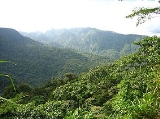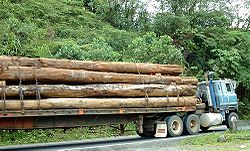
Braulio Carrillo National Park
Encyclopedia
Braulio Carrillo National Park is a National Park
of the Volcanic Cordillera Conservation Area in Costa Rica
located on the eastern edge of the central volcanic corridor between San José
and Puerto Limón. It is accessible from the Limon Highway, which bisects the park running roughly east-west, and Barva, in the north. The park contains many notable geological features, such as the Barva Volcano
, Hondura River, Patria River, and the mineral-discolored Súcio River. The park is separated into three main sectors - Zurquí, Quebrada Gonzales, and Barva.
The park contains several dormant volcanoes including Cerro Chompipe, Cerro Cacho Negro and Cerros las Tres Marias. Barva itself has three crater lakes - Barva, Danta and Copey. The park also protects areas of the Sarapiquí River
watershed, including large amounts of primary cloud and rainforest, and the flora and fauna that makes it their home.
coast.
 Because of the park's large size and its varied altitude - it descends nearly 3000 meters (9842.5 Ft or 1.86 miles) from the highest to lowest points - it is home to several distinct life zones. Ranging from high-altitude cloud forest to tropical lowlands rainforest, it maintains one of the highest levels of biodiversity in Costa Rica. More than 90% of the park is covered in primary forest, providing a unique snapshot of ancient ecological conditions.
Because of the park's large size and its varied altitude - it descends nearly 3000 meters (9842.5 Ft or 1.86 miles) from the highest to lowest points - it is home to several distinct life zones. Ranging from high-altitude cloud forest to tropical lowlands rainforest, it maintains one of the highest levels of biodiversity in Costa Rica. More than 90% of the park is covered in primary forest, providing a unique snapshot of ancient ecological conditions.
 The park contains landscapes representing the Talamancan montane forests
The park contains landscapes representing the Talamancan montane forests
ecoregion at high elevations and the Isthmian-Atlantic moist forests ecoregion at low elevations. It is significant for its biodiversity with 600 identified species of trees, over 530 species of birds, and 135 species of mammals already catalogued. Examples of birds found include the Solitary Eagle
, the Bare-necked Umbrellabird
, as well as several species of hummingbird
s. The area near Barva is home to the black-headed bushmaster
.
Unlike the more popular Costa Rican parks such as Poás
and Manuel Antonio
, this park is relatively unmaintained and untravelled. Three main ranger stations serve the park, although only two of them, Quebrada Gonzales and Barva, provide sanitary facilities and drinking water for visitors. The few available hiking trails are often narrow, ungroomed, and not regularly monitored by rangers. The trail from Puesto Barva to the La Selva Protected Zone
in the north is difficult and long - estimated to take about 4 days under good conditions. Other trails, such as Los Botarramas and El Ciebo, are much shorter measuring between 1–2 km (.6 - 1.25 mi), but are often steep, wet and uneven.
National park
A national park is a reserve of natural, semi-natural, or developed land that a sovereign state declares or owns. Although individual nations designate their own national parks differently A national park is a reserve of natural, semi-natural, or developed land that a sovereign state declares or...
of the Volcanic Cordillera Conservation Area in Costa Rica
Costa Rica
Costa Rica , officially the Republic of Costa Rica is a multilingual, multiethnic and multicultural country in Central America, bordered by Nicaragua to the north, Panama to the southeast, the Pacific Ocean to the west and the Caribbean Sea to the east....
located on the eastern edge of the central volcanic corridor between San José
San José, Costa Rica
San José is the capital and largest city of Costa Rica. Located in the Central Valley, San José is the seat of national government, the focal point of political and economic activity, and the major transportation hub of this Central American nation.Founded in 1738 by order of Cabildo de León, San...
and Puerto Limón. It is accessible from the Limon Highway, which bisects the park running roughly east-west, and Barva, in the north. The park contains many notable geological features, such as the Barva Volcano
Barva Volcano
Barva Volcano, sometimes called "Las Tres Marías" is an andesitic shield complex in central Costa Rica 22 km north of San José, in the province of Heredia. It sits on the small agricultural community of Sacramento....
, Hondura River, Patria River, and the mineral-discolored Súcio River. The park is separated into three main sectors - Zurquí, Quebrada Gonzales, and Barva.
The park contains several dormant volcanoes including Cerro Chompipe, Cerro Cacho Negro and Cerros las Tres Marias. Barva itself has three crater lakes - Barva, Danta and Copey. The park also protects areas of the Sarapiquí River
Sarapiquí River
The Sarapiquí River, or Rio Sarapiquí, in Costa Rica is a tributary of the San Juan River and forms the eastern border of Sarapiquí Canton...
watershed, including large amounts of primary cloud and rainforest, and the flora and fauna that makes it their home.
History
Established in 1978, the park was formed as an agreement with environmental lobbyists to limit and prevent development of the area after the construction of the Limon Highway, a major road linking the capital to Caribbean cargo ports. The park was named in honor of former Costa Rican president Braulio Carrillo, whose administration had helped foster the nation's early agricultural economy and had built the first road linking San José to the CaribbeanCaribbean
The Caribbean is a crescent-shaped group of islands more than 2,000 miles long separating the Gulf of Mexico and the Caribbean Sea, to the west and south, from the Atlantic Ocean, to the east and north...
coast.
Biodiversity


Talamancan montane forests
The Talamancan montane forests ecoregion, in the tropical moist broadleaf forest biome, are in montane Costa Rica and Panama in Central America.-Setting:...
ecoregion at high elevations and the Isthmian-Atlantic moist forests ecoregion at low elevations. It is significant for its biodiversity with 600 identified species of trees, over 530 species of birds, and 135 species of mammals already catalogued. Examples of birds found include the Solitary Eagle
Solitary Eagle
The Montane Solitary Eagle, Harpyhaliaetus solitarius, is a large Neotropical eagle.- Range and habitat :The Montane Solitary Eagle is native to Mexico and Central and South America. It is found in mountainous or hilly forests, at elevations between 600 m & 2,200 m...
, the Bare-necked Umbrellabird
Bare-necked Umbrellabird
The Bare-necked Umbrellabird is a species of bird in the Cotingidae family.It is found in Costa Rica and Panama....
, as well as several species of hummingbird
Hummingbird
Hummingbirds are birds that comprise the family Trochilidae. They are among the smallest of birds, most species measuring in the 7.5–13 cm range. Indeed, the smallest extant bird species is a hummingbird, the 5-cm Bee Hummingbird. They can hover in mid-air by rapidly flapping their wings...
s. The area near Barva is home to the black-headed bushmaster
Lachesis melanocephala
Lachesis melanocephala is a venomous pitviper species found in Costa Rica. No subspecies are currently recognized.-Description:Adults frequently grow to 190–200 cm in length with the largest reported specimens being 230 cm and 240 cm...
.
Unlike the more popular Costa Rican parks such as Poás
Poás Volcano National Park
Poás Volcano National Park, in Spanish , is a National Park that covers an area of approximately ; the summit is . One of the attractive features about Poás is that you can get all the way to the edge of the crater...
and Manuel Antonio
Manuel Antonio National Park
Manuel Antonio National Park, in Spanish the Parque Nacional Manuel Antonio, is a small National Park in the Central Pacific Conservation Area located on the Pacific coast of Costa Rica, just south of the city of Quepos, Puntarenas, and from the national capital of San José...
, this park is relatively unmaintained and untravelled. Three main ranger stations serve the park, although only two of them, Quebrada Gonzales and Barva, provide sanitary facilities and drinking water for visitors. The few available hiking trails are often narrow, ungroomed, and not regularly monitored by rangers. The trail from Puesto Barva to the La Selva Protected Zone
La Selva Protected Zone
La Selva Biological Station is a prominent ecology research station in Costa Rica, providing a facility of worldwide importance for tropical research. Located in Costa Rica's northeastern lowlands, La Selva includes a nature reserve that protects about of primary tropical rainforest...
in the north is difficult and long - estimated to take about 4 days under good conditions. Other trails, such as Los Botarramas and El Ciebo, are much shorter measuring between 1–2 km (.6 - 1.25 mi), but are often steep, wet and uneven.

